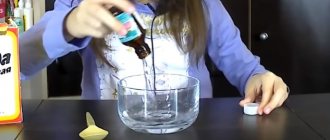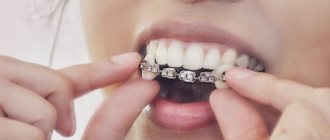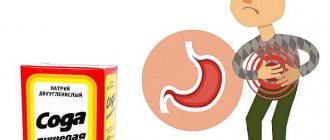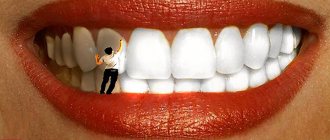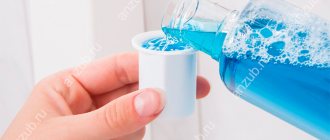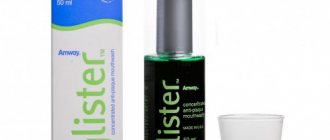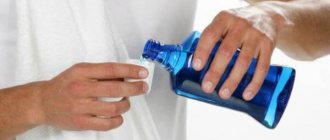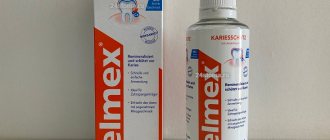Daily hygiene of teeth and gums includes rinsing the mouth with special solutions. Rinse aids can be purchased at pharmacies, or you can prepare them yourself. Their use ensures cleaning of the oral cavity in hard-to-reach places, freshening of breath and destruction of certain types of pathogenic microorganisms. You can easily make a mouthwash with your own hands, and this will be the right decision when you are intolerant to chemical components and want to make your dental hygiene as safe as possible.
How to make a mouthwash
To make a simple mouthwash you will need a few basic ingredients.
Namely:
- sea salt, which has a bactericidal effect and is rich in minerals;
- alcohol or water tincture of herbs;
- soda, which effectively cleanses bacterial plaque;
- essential oils that have good antibacterial and anti-inflammatory effects.
“Store-bought” mouthwashes contain substances such as thymol and methyl salicylate.
These are antiseptics with a toxic effect, which are contraindicated during pregnancy and are not intended for oral administration.
If accidentally swallowed, adverse reactions may occur, especially when there are diseases of the gastrointestinal tract. Rinsing your own has many benefits. You can select each ingredient yourself, which is especially important for allergy sufferers. This rinse is natural, it does not contain preservatives or dyes, which means side effects are minimized. It is also a very economical option, which is good for large families.
A DIY rinse can be a bleaching agent if you add a little apple cider vinegar or lemon juice to it. To prepare, you need to take a glass of water, a spoonful of hydrogen peroxide, 3 drops of eucalyptus oil, a teaspoon of calendula tincture. Hydrogen peroxide is first added to a glass of water, then the remaining components. The mixture is thoroughly mixed, after which you can rinse your mouth.
For an antibacterial rinse, you will need an infusion of chamomile or thyme; a decoction of oak bark is also good.
Recipe for making an antibacterial mouthwash:
- You will need two tablespoons of chamomile, a teaspoon each of salt and soda, 4 drops of tea tree oil.
- Chamomile is poured with boiling water, then filtered.
- Salt, soda and ether are added to the broth.
A good natural antiseptic is aloe, from the juice of which you can make a mouthwash. To do this, you need to mix 100 ml of mineral water, 20 drops of mint oil, a spoonful of citrus juice, a spoonful of oak bark infusion and 100 ml of aloe juice.
Composition of homemade mouth rinses
Besides being easy to make, homemade mouthwash has a much wider variety of ingredients that can be used.
Herbs
- Aloe vera gel. Aloe vera extracts have antibacterial and antifungal effects;
- Anise. A flowering plant with flavors reminiscent of licorice, dill and tarragon. Contains anethole, which has powerful antimicrobial properties against bacteria, yeast and fungi;
- Basil. An herb with a strong sweet odor. Scientific research has shown that basil oil has powerful antioxidant, anticancer, antiviral and antimicrobial effects;
- Cardamom. With a unique taste, resinous aroma. Used to treat infections of teeth and gums, prevent and treat throat diseases. Decongestant;
- Cinnamon. A spice obtained from the bark of the cinnamon tree. Suppresses the growth of bacteria, protects food from spoilage. Cinnamon is high in antioxidants. The essential oil also has antimicrobial properties;
- Carnation. Clove oil can reduce toothache. Reduces the development of infections in teeth due to antiseptic properties. The buds have antioxidant properties;
- Coriander. When crushed, the seeds emit a lemon-citrus aroma. Described as nutty, warm, spicy and orange flavored. Research has shown that the leaves and seeds contain antioxidants. But the leaves have a stronger effect.
- Eucalyptus. Eucalyptus oil is used for cleaning and deodorizing. Found in cough drops, toothpaste and decongestants. Has an antibacterial effect;
- Fennel. A very aromatic herb with culinary and medicinal uses. Contains anethole, which has an antimicrobial effect against bacteria, yeast and fungi;
- Ginger. With antibacterial effect. Stimulates saliva production;
- Goldenseal. Improves the healing of mouth ulcers;
- Marjoram. A relative of oregano, oregano. With a sweet pine and citrus taste;
- Myrrh. Used as an antiseptic in mouthwashes and toothpastes. Helps prevent gum disease. Myrrh essential oil has powerful preservative properties;
- Oregano. Leaves and flowering stems have an antiseptic and expectorant effect. High in antioxidants and antimicrobial properties;
- Peppermint. Contains menthol. Used for brewing tea, flavoring ice cream, confectionery, chewing gum and toothpaste;
- Rosemary. Contains a number of potentially bioactive compounds, including antioxidants such as carnosic and rosmarinic acid;
- Sage. With a slight spicy taste. Used as an antibiotic, antifungal, astringent;
- Thyme. Essential oil of common thyme contains 20-54% thymol. Timol is an antiseptic. The main ingredient in the liquid is Listerine. Also an active ingredient in some natural alcohol-free hand sanitizers.
- Turmeric. Antimicrobial, anti-inflammatory and antiseptic agent.
Essential oils
- Bergamot. The fruit is the size of an orange, yellow in color, similar to lemon, and has a pleasant aroma. Relieves inflammation. Has antiseptic properties;
- Lemon. The acid of lemons deodorizes, removes grease, whitens stains, and disinfects;
- Mandarin. In traditional Chinese medicine, the peel of the fruit is used to regulate qi energy, treat bloating, improve digestion and reduce phlegm;
- Tea tree. Known to be antiseptic, antibacterial, antifungal and antiviral.
DIY Mouthwash with Essential Oils
Sweeteners
- Honey. Some people like the sweet taste of the mouthwash. Honey contains more complex carbohydrates than sugar, which break down more slowly and are less likely to cause problems in the mouth;
- Stevia. About 30 times sweeter than sugar. Studies have shown that stevia inhibits the growth and reproduction of harmful bacteria that cause gum disease and tooth decay;
- Xylitol. Sweetener. Bacteria cannot feed on xylitol, so it does not cause tooth decay or bad breath.
Other components
- Apple vinegar. Gargling with apple cider vinegar is a common remedy for sore throats due to its antibacterial properties. Helps dissolve calcified deposits in the mouth. Sometimes added to mouthwash;
- Baking soda. Acts as a mechanical cleanser for teeth and gums, neutralizes acid production in the mouth. An antiseptic that helps prevent infections. A paste made from sodium bicarbonate and 3% hydrogen peroxide solution can be used as an alternative to commercial toothpastes;
- Calcium carbonate. used as an abrasive instead of fluoride to remineralize teeth;
- Glycerol. Sweet tasting moisturizer. Thickener, solvent, sweetener, preservative and 60% sweeter than sucrose. Although it has about the same nutritional energy as table sugar, it does not raise blood sugar levels. Does not serve as a breeding ground for bacteria;
- Gum arabic. Gum, acacia resin. Reduces surface tension of liquids. Serves as an emulsifier. Lowering surface tension allows fluid to more easily penetrate hard-to-reach places, such as between teeth;
- Hydrogen peroxide. Disinfectant, antiseptic, oxidizer and bleach. Can be used as a toothpaste when mixed with baking soda and salt. Should be stored in an opaque container as it degrades quickly when exposed to light.
- Salt. It is sodium chloride and acts as a preservative by absorbing water. Used in soaps, detergents and cooking. Acts as a preservative because it absorbs water from bacteria, killing them or at least inhibiting their growth;
- Vodka. Used in some recipes, although not recommended due to the presence of alcohol;
- Water. The main component of the liquid. You can experiment using boiled, mineral, carbonated or distilled water.
With essential oil
It is better to prepare rinses with essential oils in alcohol for long-term storage.
There are 2 simple recipes:
- Mix 200 ml of vodka, 20 drops of mint oil, 15 thyme, 5 sage and 5 myrrh. A teaspoon of the mixture is added to a glass of water before each rinse.
- Mix 200 ml of vodka, 10 drops of lemon juice, 15 tea tree oil, 10 lavender. This product also has a whitening effect. Applies like the previous one.
A good antibacterial rinse would be one with tea tree oil and mint. To prepare, you need to take 200 ml of water, 5 drops of mint oil and 5 tea tree oil. This product will give you a feeling of freshness and cleanliness.
Other recipes for natural alcohol-based mouthwashes:
- 200 g of vodka is mixed with 500 ml of water, 30 ml of glycerin and 10 ml of aloe juice are added to the solution. The mixture is brought to a boil, then 20 drops of mint oil are added.
- Add 5 drops of mint oil and 5 mg of cinnamon powder to a glass of vodka. This remedy should sit for several days. After preparation, the mixture is filtered and used for rinsing.
- Mix two teaspoons of mint and sage, add 5 tablespoons of red sandalwood powder. The mixture is poured with a liter of water and 200 ml of alcohol. The product is infused for a week in a dark place.
- The container contains 50 ml of water, 100 ml of vodka, 15 drops of lemon juice and 20 bergamot oil. The contents are shaken and infused for 7 days. Before use, a teaspoon of infusion is diluted in 50 ml of water.
Kinds
You should know! Among the large assortment of rinse aids offered by manufacturers, three main groups can be distinguished:
- Medicinal – used to treat inflammatory diseases. Depending on the purpose, medicinal solutions are divided into several types: antibacterial, anti-inflammatory, and also for reducing tooth sensitivity.
- Hygienic – used to mask bad breath and reduce the risk of developing inflammatory diseases. They clean teeth well of plaque and food debris, give freshness to your breath for a long time, but do not eliminate existing problems.
- Combined - used for preventive purposes. They have a positive effect on the mucous membrane and gums, thoroughly clean the interdental areas from bacterial plaque and freshen breath.
Terms of use
How to use mouthwash correctly:
- It is better to prepare solutions daily to get maximum benefit from them.
- Rinse is carried out after brushing your teeth.
- The oral cavity should be rinsed for about 2 minutes, collecting 15-20 ml of solution.
- The product should be stored in a dark place out of reach of children.
- For half an hour after rinsing, you do not need to eat anything to allow the medicinal components to act on the mucous membranes and teeth for some time.
- Under no circumstances should spoiled products be used.
For those who are experiencing toothache or inflammatory gum disease, natural rinses with iodine and salt are suitable. Soda is a natural antiseptic, and it also removes bacterial plaque well when there is an ulcer or aphthae. When there are periodontal pathologies, it is more effective to use alcohol tinctures, which can be used to rinse your mouth daily throughout the entire treatment period.
Alcohol rinses are recommended for aphthous stomatitis and various forms of gingivitis. They are contraindicated during pregnancy and for young children.
As for mouthwashes for children, they can be used from the age when the child understands that the liquid must be spit out. Before this period, the mucous membrane should be wiped with a cloth soaked in the solution.
Why is it needed: purpose
Important! Mouth rinses are designed to clean teeth and hard-to-reach areas from plaque and food particles, provide long-lasting fresh breath and prevent dental diseases.
Such products help solve a whole range of problems with gums, making them stronger and healthier.
With daily use of mouthwashes, an improvement in the hygienic condition of teeth and gums is observed.
There is also a decrease in the rate of formation of bacterial plaque and tartar.
In combination with toothpaste, a properly selected product provides the highest quality oral care.
At the same time, the likelihood of the occurrence and development of pathological processes is significantly reduced.
Dried flower flavoring
An excellent solution not only for home, but also for the office. Dried flowers not only exude a pleasant, subtle aroma, but also look very aesthetically pleasing inside a glass jar.
Dried flowers and herbs can be bought at pharmacies and stores or dried yourself. If you choose the second route, simply tie a small bouquet with thread and hang it in a sunny and well-ventilated place.
Place the plants in a jar and add a couple of drops of an essential oil that suits the aroma. So, if you have dried roses or rose hips, use rose oil. If you have lavender in your jar, enhance its natural aroma with lavender oil.
It is recommended to shake this flavoring periodically.
For cleaning the washing machine
Shutterstock
You can use Listerine type rinse liquid to disinfect the washing machine itself.
Allow the washing machine to fill with water, add one cup of rinse aid, and run a full cycle. Your washing machine will eventually be completely free of germs. see also
16 Ways to Use Candles You Probably Didn't Know About
Baking soda flavoring
Baking soda is very sensitive to odors. It will not only give off the aroma of the essential oil with which it is soaked, but also absorb unpleasant odors.
Cut a round hole in the lid of a glass jar. Cover it with scrapbooking paper and poke a lot of holes in it with a needle. You can also use a thin cotton cloth or go simpler and just pierce the metal lid with an awl in several places.
Fill a clean, dry jar with baking soda about halfway, add 8-12 drops of essential oil and shake. If the aroma does not seem intense enough, add another 5-10 drops and shake again.
